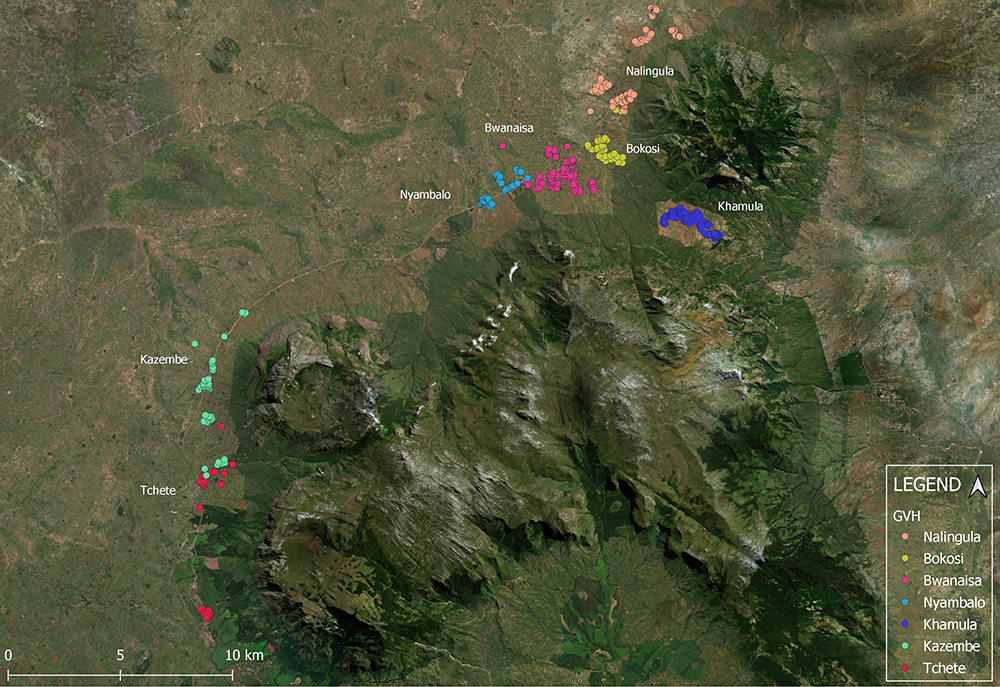
2023 was the first full year of activity for our newest legal entity, WeForest Malawi. Forest co-management in the districts of Phalombe and Mulanje is now the major focus of our project here, encompassing law enforcement, agroforestry, Assisted Natural Regeneration (ANR), livelihood support and governance assistance.
Our 12-year commitment will protect a total of around 9000 hectares (over 9 million native trees) and work with over 13 000 families inside and around this incredible Biosphere Reserve.
The major focus in the first six months was the onboarding of new team members, setting up the main office in Mulanje and a satellite office in Phalombe district and establishing the Board. Despite the challenges of tropical cyclone Freddy in March, the newly created team managed to keep the project activities on track, now working in two forest blocks of approximately 1500 ha under community protection.
One good thing that came out of the cyclone was that there’s more commitment now at the local community level to support Forest and Landscape Restoration, as national government and district and traditional leadership are realizing that restoration is crucial for natural disaster risk reduction. This was especially important as we will be playing the role of mediator and advisor between the communities and the Department of Forestry, and worked hard to solidify this relationship during 2023, assuring approval for our ambitious project’s implementation.
In two areas, Kazembe and Tchete on the western flank of the mountain, we have been supporting local communities – organized into Forest Block Committees (FBCs) – to protect and regenerate around 8 million trees of 35 different species through supporting the Forestry Department in their mandate to conduct law enforcement and ranger patrols, and fire management by establishing firebreaks and conducting early controlled burning to stop uncontrolled wildfires in the dry season.
Currently WeForest is preparing for the scaling up of this co-management model in the district of Phalombe, using our Kazembe and Tchete co-management areas in the district of Mulanje as the pilot. Overall, the project aims to scale up towards 2030 as follows:
During 2023, two “Group Village Headships” (GVHs) were identified in Phalombe district for the next stage of expansion, and boundaries for the two areas to be protected (Bwanaisa and Nyambalo) were proposed, covering approximately 1800 hectares in total. Cumulatively, by the end of 2024, we expect 3390 hectares to be under co-management, distributed as follows:
Map showing the location of current and potential GVHs in Mulanje and Phalombe. The coloured dots are the distribution of respondents in the baseline survey of these 7 Group Village Headships during 2023 (see Livelihoods, below).

Meetings were held with key stakeholders from forestry, agriculture and land departments in the Mulanje and Phalombe districts to ensure their involvement in surveys and group discussions.
The main restoration activity this year was on fire management in the established Kazembe and Tchete zones. Controlled burning, which reduces dry vegetation that can act as fuel for wildfires later in peak fire season, was carried out for the first time in June and July. Afterwards, in July and August, 12 km of firebreaks – gaps in vegetation as a barrier to stop the progress of wildfires – were constructed.
Any enrichment planting (gap filling) needed in these restoration areas is postponed until after the fire management measures have been proven to be effective.
For the newly demarcated restoration areas, controlled burning maps are under development so that this can take place before any planting or gap filling takes place.
Maintenance of the planted cedar
The survival of the Mulanje cedar (Widdringtonia whytei) was one of the driving forces behind the first phase of work in Mulanje, along with the protection of habitats of other endangered endemic species, including the Mulanje chameleon (Nadzikambia mlanjensis). Accordingly, the project’s cedar component during the first three years planted more than 320 000 seedlings of Mulanje cedar and other native companion species on the mountain.
With everything planted, it’s now a case of monitoring and maintenance, which will take place up to and including 2025. Firebreaks will be maintained for a bit longer – up to 2028. The process is well established and the new team members know exactly what to do, so the cedar is doing well. Weeding was carried out in all sites planted between 2020 and 2023 this year, and permanent monitoring plots have been established to assess the impact of weeding on survival and growth.
Muloza river catchment area – a victim of Cyclone Freddy
Our collaboration with Cedar Energy, which involved ecological restoration activities in the vicinity of the hydro-power facility with the goal of preserving and enhancing the Muloza river catchment, is no longer active, as the infrastructure of Cedar Energy on the restoration location washed away when Cyclone Freddy hit. Forest patrolling did continue throughout 2023 as WeForest equipped and trained 10 patrol members, and protection remained essential.
Our partnership with the BGCI under the Darwin Initiative project will broaden WeForest’s horizon towards inclusion of indigenous species in agroforestry designs in the buffer zone, and informs trials towards cooperative set-ups surrounding non-timber forest products in the miombo woodlands in collaboration with the Mount Mulanje Conservation Trust (MMCT). BGCI also plays a leading role in the set-up of the Global Biodiversity Standard, and together we are keen to try out the methodology in our Mulanje project.
A baseline survey was conducted with 498 households across 7 Group Village Headships during 2023: the existing areas of Kazembe and Tchete as well as the two new ones in Phalombe and three potential others (see map above). Surveys like this allow us to accurately measure the impact of our activities, in particular the improvements to household income and quality of life that our livelihoods programmes bring.
Our agroforestry scheme in the buffer zone around the mountain promotes sustainable land use practices by integrating trees and crops, enhancing ecosystem services, and improving local livelihoods. Mainly, it aims to increase the sustainable supply of fuelwood in communities to reduce pressure on the forest.
During 2023 the WeForest team conducted awareness meetings with the development committees in the communities to ensure their active participation, understanding and support of the project. Up to 80% of farmers here own the land they cultivate through inheritance, which makes it more likely that they are prepared to invest in sustainable long-term practices such as agroforestry.
The agroforestry scheme will promote the cultivation and propagation of the following tree species:
# | Species | Type | Purpose |
|---|---|---|---|
1 | Albizia lebbeck | non-native | Fuelwood; medicinal; nitrogen fixing; fodder; timber; boundary planting
|
2 | Annona senegalensis | native | Fruits; medicinal; fibre; fuelwood
|
3 | Bridelia micrantha | native | Fruits; fodder; fuelwood; timber
|
4 | Dodonaea viscosa | native | Firewood; medicine; bee forage; live fence/windbreak; crafts (tool handle)
|
5 | Faidherbia albida | native | Fuelwood; fodder;
nitrogen fixing; shade; timber; medicine
|
6 | Gliricidia sepium | non-native | Weed control (e.g. striga); fuelwood; fodder; nitrogen fixing
|
7 | Khaya anthotheca | native | Timber |
8 | Newtonia buchananii | native | Timber; shade in tea plantation; ornamental |
9 | Oxytenanthera abyssinica | native | Building material; weaving; live fencing |
9 | Senna siamea | non-native | Fodder; fuelwood; nitrogen fixing |
10 | Senna spectabilis | non-native | Poles; fuelwood; nitrogen fixing |
11 | Uapaca kirkiana | native | Fruits; fuelwood |
These species have been selected based on the preference of community members and the benefits they seek from agroforestry which are: fuelwood, poles/timber, and crop productivity. Establishing 50 tree nurseries at village level will supply the required 250 000 seedlings per year for agroforestry.
A critical part of the project involves the training of lead farmers in agroforestry: integrating trees among crops, establishing hedgerows (boundary planting), encircling homesteads with trees, and establishing woodlots. These lead farmers will then extend this knowledge to other smallholder farmers within their communities, with an overall engagement target of 1225 households for the year 2023.
During 2022, the agroforestry pilot, in which 12 600 seedlings were distributed to 115 farmers trained in agroforestry, was unfortunately affected by the cyclone in March 2023, with only a third of the seedlings surviving. The programme will now continue with the establishment of agroforestry plots on the other side of the mountain near our co-management areas.
50 lead farmers and their respective follower farmers started establishing their agroforestry in January 2024, soon after completing the training. In the Mulanje and Phalombe landscape, it is difficult for farmers to set aside specific areas just for agroforestry, as land is limited. As a result, the common approach to incorporate agroforestry is boundary planting and interplanting/cropping. At the time of writing, all of them have finished planting over 75 000 seedlings.
Beehives have amazing potential to prevent deforestation. The revenue received through selling honey can provide a significant income for the farmer and his or her family, and more importantly provide sustainable finance to provide the financial muscle to the co-management entities to manage the forest resources. Since bees need healthy flowering trees to flourish, they provide a great incentive to keep the trees standing, and the extra income means there’s less need to make money from illegal logging and charcoal burning.
Our beekeeping programme works on a benefit-sharing arrangement so that hives are donated to the Forest Block Committees (FBCs) and managed by local beekeepers. The beekeeping groups harvest the honey and the FBCs sell it. 25% goes to the beekeepers for their services, while 75% stays with the FBC to support the restoration activities: law enforcement and establishing and maintaining firebreaks. This system was reviewed and a revision process is currently underway.
A Market Systems Development (MSD) study was carried out in 2023 by Bees for Development (UK) to study the honey market, identify challenges and see how we can improve the system to ensure a good first return for our honey. This report was finalized at the end of August, and since then it has been informing the strategizing of the beekeeping programme. Bees for Development also provided some training in beekeeping to the WeForest Malawi team.
Of the 400 beehives hung by beekeeping groups in Kazembe, Mangombo, Nakhonyo, Mwanyali and Nkanda in 2022, 29 sustained damage by Tropical Cyclone Freddy and another 30 were stolen. Strong law enforcement in the forest blocks (see Stewardship and Governance, below) should ensure that this does not happen in future.
During 2023, a great deal of consultation was done to make sure that the project is approved by all stakeholders. District Environmental Sub-Committee (DESC) and District Executive Committee (DEC) meetings were held in Mulanje and Phalombe, and a technical presentation was given to 17 regional and national Department of Forestry staff members during a meeting in Lilongwe. The project was approved for implementation in both districts.
The development of the Forest Management Plan and co-management agreement continued in 2023, and the bylaws were reviewed by an external forestry expert.
One challenge in this area is the continued escalation of deforestation as a result of charcoal production, which is carried out by very well organised groups who are sometimes armed. The village heads and local communities are keen to work with WeForest to build up forest patrols and become fully equipped. In 2023, 55 uniforms and boots were provided by WeForest through the District Forestry Office for use in patrolling Kazembe and Tchete.
During 2023, 26 community volunteers were trained in law enforcement in collaboration with the Malawi College of Forestry, with parades and competitions such as the competitive selection process helping to boost visibility and encourage more community volunteers to get involved. This will continue in 2024, as more volunteers are still needed!
Free Prior and Informed Consent (FPIC)
At WeForest, it’s important that we have a process of Free Prior and Informed Consent (FPIC) in place for communities to be able to vote to accept a project in the area or not. Here in Malawi, WeForest presented the project concept to the Area Development Committee at Traditional Authority level and to the Village Development Committee at Village Headship level. For Phalombe, this was being done in January and February 2024.
Every hectare under restoration is mapped with GPS points to generate polygons (areas on a map) that are assigned to sponsors. Permanent monitoring plots are established in our sites and our forestry and science teams conduct surveys to monitor progress of biomass growth, tree density, survival rate and species diversity, among other indicators. Where social impacts are also critical, we measure socio- economic indicators such as the number of beneficiaries, people trained, and income generated from forest-friendly livelihood activities.
Please visit our What We Do web page for more information.
Thank you for supporting the Mount Mulanje project!
HQ (BE): WeForest asbl/vzw
Cantersteen 47, 1000 Brussels, Belgium
VAT number BE0826.151.968
Incorporated May 26th 2010
WeForest is a supporting member of:





| Cookie | Duration | Description |
|---|---|---|
| __cf_bm | 1 hour | This cookie, set by Cloudflare, is used to support Cloudflare Bot Management. |
| _GRECAPTCHA | 6 months | Google Recaptcha service sets this cookie to identify bots to protect the website against malicious spam attacks. |
| cookielawinfo-checbox-analytics | 11 months | This cookie is set by GDPR Cookie Consent plugin. The cookie is used to store the user consent for the cookies in the category "Analytics". |
| cookielawinfo-checbox-functional | 11 months | The cookie is set by GDPR cookie consent to record the user consent for the cookies in the category "Functional". |
| cookielawinfo-checbox-others | 11 months | This cookie is set by GDPR Cookie Consent plugin. The cookie is used to store the user consent for the cookies in the category "Other. |
| cookielawinfo-checkbox-advertisement | 1 year | Set by the GDPR Cookie Consent plugin, this cookie records the user consent for the cookies in the "Advertisement" category. |
| cookielawinfo-checkbox-necessary | 11 months | This cookie is set by GDPR Cookie Consent plugin. The cookies is used to store the user consent for the cookies in the category "Necessary". |
| cookielawinfo-checkbox-performance | 11 months | This cookie is set by GDPR Cookie Consent plugin. The cookie is used to store the user consent for the cookies in the category "Performance". |
| CookieLawInfoConsent | 1 year | CookieYes sets this cookie to record the default button state of the corresponding category and the status of CCPA. It works only in coordination with the primary cookie. |
| elementor | never | The website's WordPress theme uses this cookie. It allows the website owner to implement or change the website's content in real-time. |
| JSESSIONID | session | New Relic uses this cookie to store a session identifier so that New Relic can monitor session counts for an application. |
| Path | session | Description is currently not available. |
| viewed_cookie_policy | 11 months | The cookie is set by the GDPR Cookie Consent plugin and is used to store whether or not user has consented to the use of cookies. It does not store any personal data. |
| Cookie | Duration | Description |
|---|---|---|
| _hjAbsoluteSessionInProgress | 1 hour | Hotjar sets this cookie to detect a user's first pageview session, which is a True/False flag set by the cookie. |
| _hjIncludedInSessionSample_2773626 | 1 hour | Description is currently not available. |
| aka_debug | session | Vimeo sets this cookie which is essential for the website to play video functionality. |
| authstrategy | session | Description is currently not available. |
| li_gc | 6 months | Linkedin set this cookie for storing visitor's consent regarding using cookies for non-essential purposes. |
| lidc | 1 day | LinkedIn sets the lidc cookie to facilitate data center selection. |
| pll_language | 1 year | Polylang sets this cookie to remember the language the user selects when returning to the website and get the language information when unavailable in another way. |
| UserMatchHistory | 1 month | LinkedIn sets this cookie for LinkedIn Ads ID syncing. |
| Cookie | Duration | Description |
|---|---|---|
| SRM_B | 1 year 24 days | Used by Microsoft Advertising as a unique ID for visitors. |
| Cookie | Duration | Description |
|---|---|---|
| _ga | 1 year 1 month 4 days | Google Analytics sets this cookie to calculate visitor, session and campaign data and track site usage for the site's analytics report. The cookie stores information anonymously and assigns a randomly generated number to recognise unique visitors. |
| _ga_* | 1 year 1 month 4 days | Google Analytics sets this cookie to store and count page views. |
| _gcl_au | 3 months | Google Tag Manager sets the cookie to experiment advertisement efficiency of websites using their services. |
| _hjFirstSeen | 1 hour | Hotjar sets this cookie to identify a new user’s first session. It stores the true/false value, indicating whether it was the first time Hotjar saw this user. |
| _hjSession_* | 1 hour | Hotjar sets this cookie to ensure data from subsequent visits to the same site is attributed to the same user ID, which persists in the Hotjar User ID, which is unique to that site. |
| _hjSessionUser_* | 1 year | Hotjar sets this cookie to ensure data from subsequent visits to the same site is attributed to the same user ID, which persists in the Hotjar User ID, which is unique to that site. |
| ajs_anonymous_id | 1 year | This cookie is set by Segment to count the number of people who visit a certain site by tracking if they have visited before. |
| ajs_group_id | 1 year | This cookie is set by Segment to track visitor usage and events within the website. |
| ajs_user_id | 1 year | This cookie is set by Segment to help track visitor usage, events, target marketing, and also measure application performance and stability. |
| AnalyticsSyncHistory | 1 month | Linkedin set this cookie to store information about the time a sync took place with the lms_analytics cookie. |
| CLID | 1 year | Microsoft Clarity set this cookie to store information about how visitors interact with the website. The cookie helps to provide an analysis report. The data collection includes the number of visitors, where they visit the website, and the pages visited. |
| CONSENT | 2 years | YouTube sets this cookie via embedded YouTube videos and registers anonymous statistical data. |
| MR | 7 days | This cookie, set by Bing, is used to collect user information for analytics purposes. |
| s_vi | 2 years | An Adobe Analytics cookie that uses a unique visitor ID time/date stamp to identify a unique vistor to the website. |
| SM | session | Microsoft Clarity cookie set this cookie for synchronizing the MUID across Microsoft domains. |
| VISITOR_PRIVACY_METADATA | 6 months | Description is currently not available. |
| vuid | 1 year 1 month 4 days | Vimeo installs this cookie to collect tracking information by setting a unique ID to embed videos on the website. |
| Cookie | Duration | Description |
|---|---|---|
| ANONCHK | 10 minutes | The ANONCHK cookie, set by Bing, is used to store a user's session ID and verify ads' clicks on the Bing search engine. The cookie helps in reporting and personalization as well. |
| bcookie | 1 year | LinkedIn sets this cookie from LinkedIn share buttons and ad tags to recognize browser IDs. |
| bscookie | 1 year | LinkedIn sets this cookie to store performed actions on the website. |
| IDE | 1 year 24 days 1 minute | Google DoubleClick IDE cookies store information about how the user uses the website to present them with relevant ads according to the user profile. |
| li_sugr | 3 months | LinkedIn sets this cookie to collect user behaviour data to optimise the website and make advertisements on the website more relevant. |
| muc_ads | 1 year 1 month 4 days | Twitter sets this cookie to collect user behaviour and interaction data to optimize the website. |
| MUID | 1 year 24 days | Bing sets this cookie to recognise unique web browsers visiting Microsoft sites. This cookie is used for advertising, site analytics, and other operations. |
| personalization_id | 1 year 1 month 4 days | Twitter sets this cookie to integrate and share features for social media and also store information about how the user uses the website, for tracking and targeting. |
| test_cookie | 15 minutes | doubleclick.net sets this cookie to determine if the user's browser supports cookies. |
| VISITOR_INFO1_LIVE | 6 months | YouTube sets this cookie to measure bandwidth, determining whether the user gets the new or old player interface. |
| YSC | session | Youtube sets this cookie to track the views of embedded videos on Youtube pages. |
| yt-remote-connected-devices | never | YouTube sets this cookie to store the user's video preferences using embedded YouTube videos. |
| yt-remote-device-id | never | YouTube sets this cookie to store the user's video preferences using embedded YouTube videos. |
| yt.innertube::nextId | never | YouTube sets this cookie to register a unique ID to store data on what videos from YouTube the user has seen. |
| yt.innertube::requests | never | YouTube sets this cookie to register a unique ID to store data on what videos from YouTube the user has seen. |
| Cookie | Duration | Description |
|---|---|---|
| __tld__ | session | Description is currently not available. |
| ajscookies | 1 year | No description available. |
| ajstest | 1 year | No description available. |
| debug | never | No description available. |